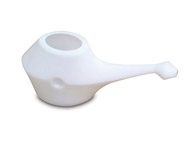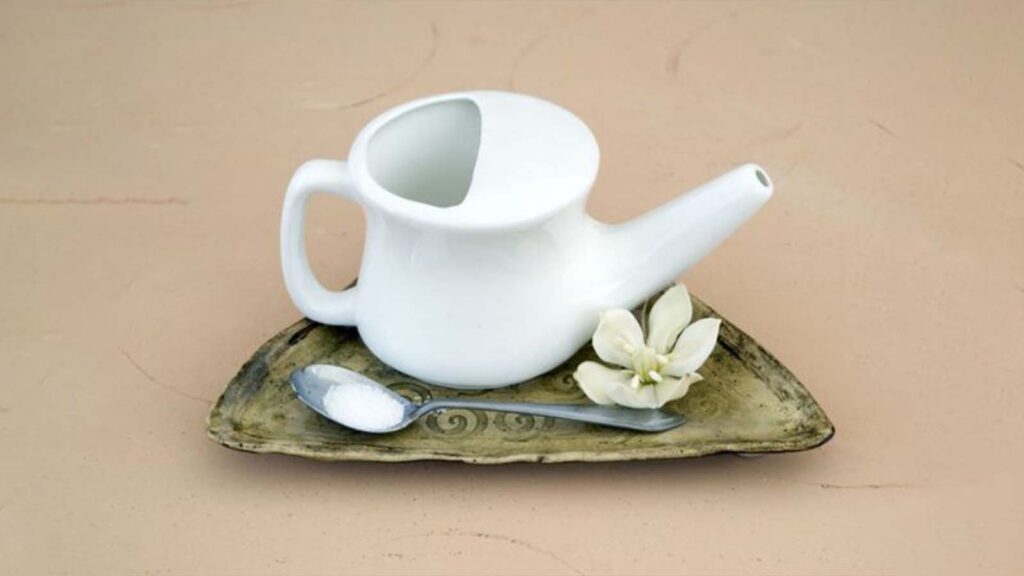Practicing yoga asanas, even doing gentle poses for just 15 minutes a day, releases tension from our bodies, reduces our stress, and strengthens our immune system, all of which help keep away winter ills like coughs and colds. Doing Salute to the Sun regularly is also quite beneficial for building up resistance to coughs and colds. Yoga asanas in general help us breathe more fully, which strengthens our lungs and helps make them more resilient to viruses that are often floating around. Regular practice is key for prevention, because once you catch a cold, it’s best to rest. It’s likely you won’t feel much like doing asanas anyway, at least not until you’re well on the way to recovery.
One technique that I have found invaluable for prevention and during a cold is neti, one of yoga’s cleansing techniques. Letting warm, salty water flow through your nasal passages cleanses the nostrils and sinuses, washing out not only dirt and pollution, but also any viruses you may have picked up. So it’s especially useful during cold and flu season. I recommend doing neti when you get home from the mall, a crowded restaurant, or anywhere you may have been exposed to airborne cold or flu bugs.
If you do happen to catch a cold and start to get a little stuffy, neti clears out the mucus and lets you breathe more easily. You’ll be surprised at how much more comes out with neti as opposed to just blowing your nose. The only time you may not be able to do it is if you’re totally stuffed up, so just give it a break on those days and resume when you can.

You can practice neti using the palm of your hand. However, most people find it easiest to practice neti with a neti pot, like those available on our website. The difference is that with the neti pot, the salt water flows in one nostril and out the other, whereas when you use your hand, the water goes in one nostril and out your mouth. Here are the instructions for using the neti pot.
How to Practice Neti with a Neti Pot
- Get a neti pot, some salt, and clean water (distilled or sterilized—see below). The water should be room temperature or warm—not hot. Use clean non-iodized cooking salt, without any additives or flavorings.
- Pour clean, warm water into the neti pot and completely dissolve the salt in it. Most neti pots hold about 1 cup of water, so a level half teaspoon of salt should be about right. (You can use a little more or less according to what feels comfortable.)
- Wash your hands thoroughly.
- Do some preliminary cleansing of the nostrils by wetting your little finger and running it alongside the inside of your nostrils to clear out any mucus or dirt.
- Place the tip of the spout in the nostril that feels the most open—from the side, not from the front—and press lightly up into the nostril so the nostril closes snugly around the tip.
- Bend slightly forward from your hips so your head is over the sink.
- Slowly tip your head downward and turn your head a little to the side, away from the neti pot, so the spout is in the upper nostril.
- Keep your chin tucked in toward your body, not sticking out.
- Breathe through your mouth, allowing the warm water to travel up through your upper nasal passages and out the other nostril. You may need to adjust the angle of your head slightly to let the water flow out the other nostril.
- When about half the water has run through, raise your head and remove the pot. A little water will run out of your nose, and you can empty your nostrils by closing one at a time and blowing gently out the other nostril. Make sure you don’t blow out of two nostrils at once. When blowing your nose, always have one nostril closed.
- Repeat steps 4-9 on the other side of your nose.
Draining Your Sinuses
It’s important to drain most, if not all, the water out of your sinuses after doing neti. Since our sinus membranes are very delicate, however, we need to make sure we don’t blow too hard or forcefully as we may damage our sinus membranes or our ears. Here’s a good way to drain the sinuses:
- Bend forward so the top of your head is hanging down.
- Turn your head to the side.
- Hold some tissue paper in front of your nose. Close the lower nostril with one finger and blow gently, not hard, through the upper nostril.
- Move your head to a horizontal position, facing the floor, and blow out of the same nostril. Blow a couple of times in each position.
- If necessary, repeat steps 3 and 4.
- Repeat on the other side.
- Stand up and blow a few times in and out of each nostril, one nostril at a time, to dry the nose.
Sterilizing the Water: You can sterilize water by bringing it to a rolling boil. Remove from the heat, cover, and allow to cool to room temperature before use. (A small amount of the hot water can be used to sterilize the tip of the neti pot prior to use.) The neti pot itself should be washed with soap and warm water.
Hints
- If the air is very dirty in your area, or if you have a lot of mucus or dirt in your nose, then after the preliminary cleansing of the nostrils (step 3), suck a little water up one nostril and blow it out the same nostril. Do this a few times until the water is clear, then repeat on the other side.
- Whether you choose to use the palm of your hand or a neti pot, if you feel a burning sensation as the water passes through your nasal passages, this may be because the nostrils are not used to having water pass through them or because the water is too cold, too salty, or not salty enough.
- It’s best not to do neti too close to bedtime as potential postnasal drip could disturb your sleep.



